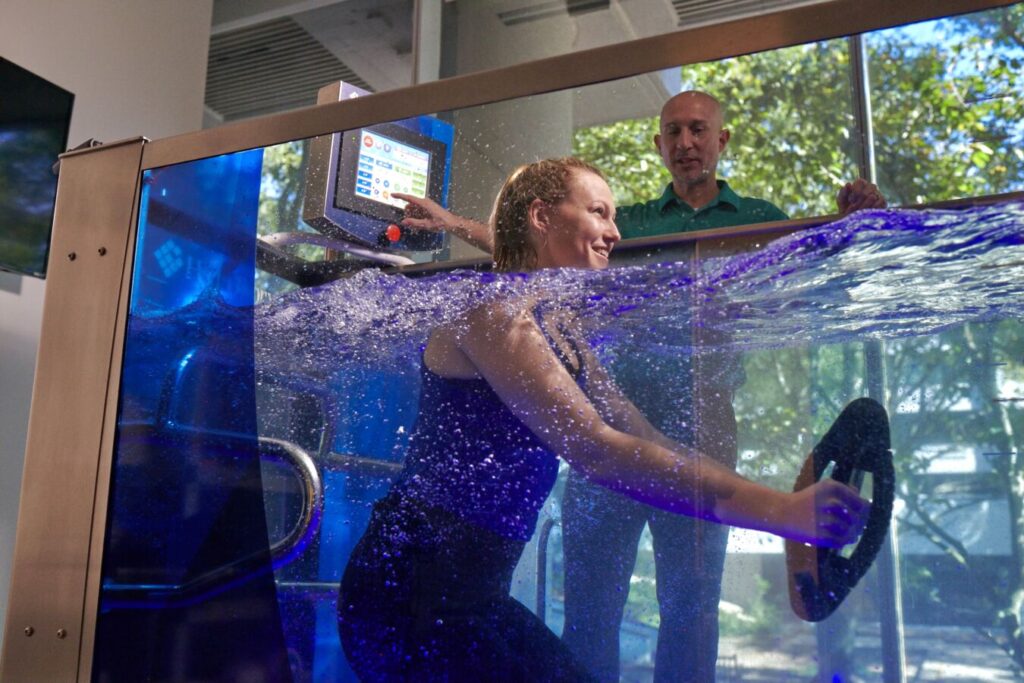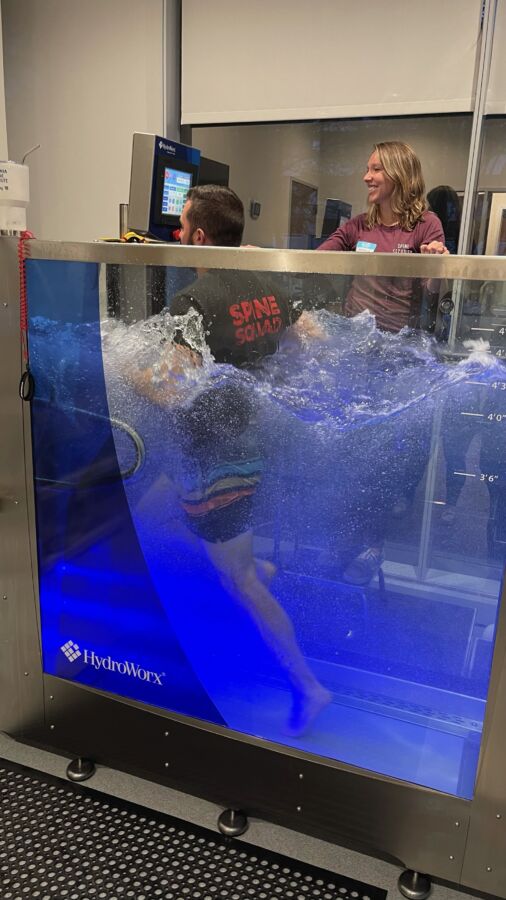Facility Spotlight: VTFC Is Improving Patient Outlook with Aquatic Therapy
We recently sat down with Casey Edwards, DPT from Virginia Therapy & Fitness Center (VTFC), and learned more about their business and how they use aquatic therapy in their HydroWorx 350. VTFC is a subsidiary of Virginia Spine Institute, and while it seems natural that they receive many of their referrals through Virginia Spine Institute, they have actually evolved to be about 60% internal referrals and 40% external referrals.
True Transformation
Our favorite part of the interview was hearing about a patient who had such an incredible transformation using the water. The PTs at VTFC see some complicated and advanced cases. Since they are an out-of-network provider, they are often a second attempt at physical therapy after the patients’ first attempts of surgery or therapy have not worked as they expected.
In this case, the patient had flatback syndrome after a prior fusion fused too straight and had to have a revision surgery, which involved most of the thoracic and lumbar spine. This male patient was deconditioned and weak and was not progressing as expected. VTFC started doing land-based physical therapy while his sutures were healing, with a plan to transition to aquatic therapy when he was ready. The patient was skeptical of the underwater treadmill, but Casey advocated for the benefits of aquatic therapy, and eventually, his wife snuck his bathing suit into his bag for PT and they convinced him to get in.
Casey had never seen him laugh, smile, or enjoy himself during any of his interactions with him. On the first day in the water, he was doing all of those things. In fact, his wife said it was the happiest he had been in a long time.
Initially, Casey had little faith in how much better he could get after the setbacks this man had endured and his overall mental outlook. After 5-6 weeks using the HydroWorx 350, he was having a dance party, splashing water, creating music videos – just major transformation: physically and mentally! Where he previously couldn’t walk across the room, he was doing jumping-jacks in HydroWorx 350. After his time in the water, this patient moved off of dependence on a walker to minimal use of a cane. It was amazing that it could be that different when you just take bodyweight out of the equation.
Patient Response
Most patients have a similar response when they see the HydroWorx 350. They immediately recognized that this is a serious thing – it’s a high-tech piece of equipment that is very specialized. Patients can tell that we are willing to invest in their care. When they find out that it’s not just a body of water but that they can change the height of the water by an inch, or the speed of the underwater treadmill by a tenth of a mile, they understand that it is an important modality.
“At the end of the day, they know this is not anywhere, not a lot of clinics have this sort of thing. It sets us apart from any clinic that neighbors us here in this region. It’s a good feeling to have something that people are really curious about..”
Casey Edwards, DPT, VTFC
Not only are patients impressed with the technology when they see it, but they also make some great gains once they get in. Patients don’t realize how much work they’ve been doing; they can go so much longer in the water than they sometimes can on land. They look at their elapsed time and are amazed at their stamina to do things that are so much harder on land. Even if it’s something they can do on land, but is difficult, or they can only do one or two repetitions (such as a 10” or 12” step-up), it is often better to put them in the water so that they can get more volume. It feels better for the patients to think, “Oh I can do this!” rather than them feeling like they can barely do it or that they need someone to manually move them. The impact on their mental outlook is so meaningful.
Aquatics Model
VTFC has a dozen physical therapists on staff at any time, and ALL of them use aquatics. There is not one PT responsible for filling the water, they all share the HydroWorx 350 under a “first come first served” policy. They see about eight patients per day in the water and every treatment is one-on-one with the therapist and patient. The water is used a lot for post-op patients and they have recently seen more younger high school athletes coming in and they have been using the water for some ankle sprains.
While VTFC sees a wide range of patients, they specialize in spine conditions and surgery recovery, and also treat competitive athletes and orthopedic injuries.. They do see some vestibular and concussions as well, and less than 10% are surgical cases and they are working to bridge some into exercise and athletics. Aquatics has always been a staple in their offerings because of the lumbar patients: it is so beneficial for them.
Lumbar fusions are the most common patients that use aquatics because they know it’s the best early rehab. Since he knows he will be putting a lumbar fusion case in the water, Casey is quick to get them on the schedule 2-3 weeks out after surgery to make sure they get a time slot. He prefers to make sure patients get in the HydroWorx 350 for at least 30-minutes and prefers a full hour if they are capable.
Advice on Succeeding with Water
Understanding that just purchasing a great new modality doesn’t just automatically equal success, Casey provided a few tips on how to succeed with a piece of equipment such as a freestanding underwater treadmill unit:
- Recognize your available budget and space and how quickly you want to recoup the money – then make a plan.
- Just having the unit will draw interest to bring more business in, because you have something no one else has – but you need to let people know you have it.
- Talk to physicians to let them know you have this.
- Consider diverse diagnoses, don’t limit yourself just to orthopedics. We’ve seen success with: Amplified musculoskeletal pain from pediatric specialist referrals, SMA, Cerebral Palsy, limb lengthening procedures.
- Face to face marketing is a key to success: getting out in the local community, sponsoring a local race, reaching out to local running clubs to rent it, meet with local school teams to refer their athletes.
- Promote it for rehab, performance, cross-training.
- Identify the hours you want to offer aquatic therapy and make a schedule.
- If you consider doing out of pocket time slots such as half hour and hour rentals – avoid discounting service because it is important to believe that what you have is worth what you are charging.
To learn more about how to gain referrals for aquatic therapy, download our Referrals Tip Sheet>>



